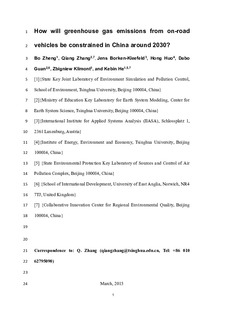| dc.contributor.author | Zheng, Bo | |
| dc.contributor.author | Zhang, Qiang | |
| dc.contributor.author | Borken-Kleefeld, Jens | |
| dc.contributor.author | Huo, Hong | |
| dc.contributor.author | Guan, Dabo | |
| dc.contributor.author | Klimont, Zbigniew | |
| dc.contributor.author | Peters, Glen Philip | |
| dc.contributor.author | He, Kebin | |
| dc.date.accessioned | 2018-03-21T10:27:53Z | |
| dc.date.available | 2018-03-21T10:27:53Z | |
| dc.date.created | 2015-09-24T13:40:18Z | |
| dc.date.issued | 2015 | |
| dc.identifier.citation | Applied Energy. 2015, 156 230-240. | |
| dc.identifier.issn | 0306-2619 | |
| dc.identifier.uri | http://hdl.handle.net/11250/2491437 | |
| dc.description.abstract | Increasing emissions from road transportation endanger China’s objective to reduce national greenhouse gas (GHG) emissions. The unconstrained growth of vehicle GHG emissions are mainly caused by the insufficient improvement of energy efficiency (kilometers traveled per unit energy use) under current policies, which cannot offset the explosion of vehicle activity in China, especially the major southern provinces. More stringent polices are required to decline GHG emissions in these provinces, and thereby help to constrain national total emissions. In this work, we make a provincial-level projection for vehicle growth, energy demand and GHG emissions to evaluate vehicle GHG emission trends under various policy options in China and determine the way to constrain national emissions. Through sensitivity analysis of various single policies, we propose an integrated policy set to assure the objective of peak national vehicle GHG emissions be achieved around 2030. The integrated policy involves decreasing the use of urban light-duty vehicles by 25%, improving fuel economy by 25% by 2035 comparing 2020, and promoting electric vehicles and biofuels. The stringent new policies would allow China to constrain GHG emissions from road transport sector around 2030. This work provides a perspective to understand vehicle GHG emission growth patterns in China’s provinces, and proposes a strong policy combination to constrain national GHG emissions, which can support the achievement of peak GHG emissions by 2030 promised by the Chinese government. | |
| dc.language.iso | eng | |
| dc.title | How will greenhouse gas emissions from motor vehicles be constrained in China around 2030? | |
| dc.type | Peer reviewed | |
| dc.type | Journal article | |
| dc.description.version | submittedVersion | |
| dc.source.pagenumber | 230-240 | |
| dc.source.volume | 156 | |
| dc.source.journal | Applied Energy | |
| dc.identifier.doi | 10.1016/j.apenergy.2015.07.018 | |
| dc.identifier.cristin | 1267290 | |
| dc.relation.project | Norges forskningsråd: 235523 | |
| cristin.unitcode | 7475,0,0,0 | |
| cristin.unitname | CICERO Senter for klimaforskning | |
| cristin.ispublished | true | |
| cristin.fulltext | preprint | |
| cristin.qualitycode | 1 | |
